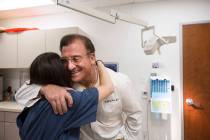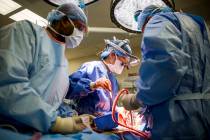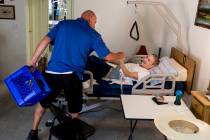Boomers’ activity, weight, account for more knee replacements
At the age of 57, Dr. Todd Swanson has done 6,000 of the procedures that studies show number more than 600,000 a year in the United States: knee replacements.
Baby boomers, says the surgeon who’s been practicing in Las Vegas for 25 years, make up a large number of the patients who undergo the operation that the Journal of Bone and Joint Surgery predicts will be performed on an astonishing 3 million men and women by the year 2030.
That astronomical increase, Swanson says, can largely be explained by boomers being more active in their later years.
And by carrying too much weight.
According to experts, obesity increases the risk of osteoarthritis, the leading cause of knee replacement surgery. Studies have shown that weight loss reduces knee pain in patients with osteoarthritis.
Walt Cooper, a retired toolmaker who moved from the Midwest to Las Vegas, believes he wouldn’t have needed either a knee replacement or two hip replacements if he had lost at least 30 pounds.
“It’s just not stressed enough by doctors,” he said. “After what I’ve gone through, I can definitely tell you I would have worked hard to lose the weight … there’s a lot of pain involved.””
Cooper says he’s not blaming physicians “because patients should really do their homework before deciding to have a procedure.”
Since his operations, he says he’s read studies that he should have read years ago.
“People need to educate themselves,” said Cooper, a former top amateur bowler. “Once you get those procedures you do have limitations.”
Swanson, who practices with Desert Orthopaedic Center, said studies show about 95 percent of patients are pleased with knee replacements.
“It gets rid of pain so they can go on with a normal life,” he said.
The surgeon said it takes him around an hour to perform the procedure that statistics show costs more than $20,000 for surgery, physical therapy and related expenses.
Insurance covers much of the cost for the procedure that takes patients six months to a year to cover completely from, according to the American Association of Hip and Knee Surgeons.
Most people can go back to normal activities within three months.
“I’ve had people run marathons and do triathlons after knee replacements,” Swanson said.
Paul Harasim’s column runs Sunday, Tuesday and Friday in the Nevada section and Thursday in the Life section. Contact him at pharasim@reviewjournal.












